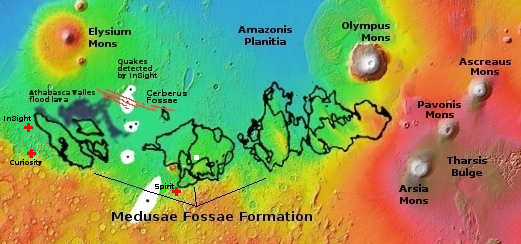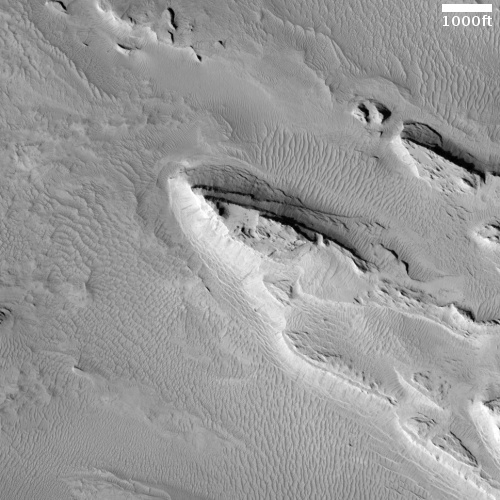A Martian ship’s prow
Cool image time! The photo to the right, cropped, reduced, and sharpened to post here, was taken on August 31, 2022 by the high resolution camera on Mars Reconnaissance Orbiter (MRO). It shows what the scientists call “layering” surrounding this pointed mesa, which I roughly estimate to be somewhere between 200 to 400 feet high.
As you approach the mesa you first walk on the dust-covered flat plains. Then you start up a slope of what looks like alluvial fill, material that over time has fallen from the mesa to pile up as an apron at its base. You then reach a series of terraces, each likely marking a different layering major event from sometime in the distance past. Over time, for unknown reasons, the material surrounding this material has eroded away, while the mesa and its layers somehow survived.
The overview map below helps tell us what those past layering events were, as well as the source of the large amount of dust and sand at this location.

The white dot in the center of the Medusae Fossae Formation marks this mesa’s location. The Medusae, located in the dry equatorial regions of Mars, is the red planet’s largest volcanic ash deposit, and is thought to be the source of most of its windblown dust and sand. It was probably produced by the many eruptions several billion years ago from the many giant volcanoes that surround it. It is this volcanic ash that makes up the dust and sand dunes seen here.
Those eruptions, along with many other lava events in these open plains (such as the Athabasca Valles flood lava, thought to be the youngest), also provided the base on which the volcanic ash sits, a plain of lava that filled the craters from the planet’s initial formation to produce this flat relatively featureless terrain. If you look at the full image you will see several craters that appear filled, partly by dust but with lava as well.
Those eruptions also each laid down different layers of lava, producing the terraced layers on the mesa, with the oldest on the bottom.
The geological mystery that scientists must untangle is the sequence of events, from lava flow to erosion to lava flow to dust deposition to erosion. To do that however will require in situ investigations to get samples that can be dated.
Want to go?
On Christmas Eve 1968 three Americans became the first humans to visit another world. What they did to celebrate was unexpected and profound, and will be remembered throughout all human history. Genesis: the Story of Apollo 8, Robert Zimmerman's classic history of humanity's first journey to another world, tells that story, and it is now available as both an ebook and an audiobook, both with a foreword by Valerie Anders and a new introduction by Robert Zimmerman.
The print edition can be purchased at Amazon or from any other book seller. If you want an autographed copy the price is $60 for the hardback and $45 for the paperback, plus $8 shipping for each. Go here for purchasing details. The ebook is available everywhere for $5.99 (before discount) at amazon, or direct from my ebook publisher, ebookit. If you buy it from ebookit you don't support the big tech companies and the author gets a bigger cut much sooner.
The audiobook is also available at all these vendors, and is also free with a 30-day trial membership to Audible.
"Not simply about one mission, [Genesis] is also the history of America's quest for the moon... Zimmerman has done a masterful job of tying disparate events together into a solid account of one of America's greatest human triumphs."--San Antonio Express-News
Cool image time! The photo to the right, cropped, reduced, and sharpened to post here, was taken on August 31, 2022 by the high resolution camera on Mars Reconnaissance Orbiter (MRO). It shows what the scientists call “layering” surrounding this pointed mesa, which I roughly estimate to be somewhere between 200 to 400 feet high.
As you approach the mesa you first walk on the dust-covered flat plains. Then you start up a slope of what looks like alluvial fill, material that over time has fallen from the mesa to pile up as an apron at its base. You then reach a series of terraces, each likely marking a different layering major event from sometime in the distance past. Over time, for unknown reasons, the material surrounding this material has eroded away, while the mesa and its layers somehow survived.
The overview map below helps tell us what those past layering events were, as well as the source of the large amount of dust and sand at this location.

The white dot in the center of the Medusae Fossae Formation marks this mesa’s location. The Medusae, located in the dry equatorial regions of Mars, is the red planet’s largest volcanic ash deposit, and is thought to be the source of most of its windblown dust and sand. It was probably produced by the many eruptions several billion years ago from the many giant volcanoes that surround it. It is this volcanic ash that makes up the dust and sand dunes seen here.
Those eruptions, along with many other lava events in these open plains (such as the Athabasca Valles flood lava, thought to be the youngest), also provided the base on which the volcanic ash sits, a plain of lava that filled the craters from the planet’s initial formation to produce this flat relatively featureless terrain. If you look at the full image you will see several craters that appear filled, partly by dust but with lava as well.
Those eruptions also each laid down different layers of lava, producing the terraced layers on the mesa, with the oldest on the bottom.
The geological mystery that scientists must untangle is the sequence of events, from lava flow to erosion to lava flow to dust deposition to erosion. To do that however will require in situ investigations to get samples that can be dated.
Want to go?
On Christmas Eve 1968 three Americans became the first humans to visit another world. What they did to celebrate was unexpected and profound, and will be remembered throughout all human history. Genesis: the Story of Apollo 8, Robert Zimmerman's classic history of humanity's first journey to another world, tells that story, and it is now available as both an ebook and an audiobook, both with a foreword by Valerie Anders and a new introduction by Robert Zimmerman.
The print edition can be purchased at Amazon or from any other book seller. If you want an autographed copy the price is $60 for the hardback and $45 for the paperback, plus $8 shipping for each. Go here for purchasing details. The ebook is available everywhere for $5.99 (before discount) at amazon, or direct from my ebook publisher, ebookit. If you buy it from ebookit you don't support the big tech companies and the author gets a bigger cut much sooner.
The audiobook is also available at all these vendors, and is also free with a 30-day trial membership to Audible.
"Not simply about one mission, [Genesis] is also the history of America's quest for the moon... Zimmerman has done a masterful job of tying disparate events together into a solid account of one of America's greatest human triumphs."--San Antonio Express-News


